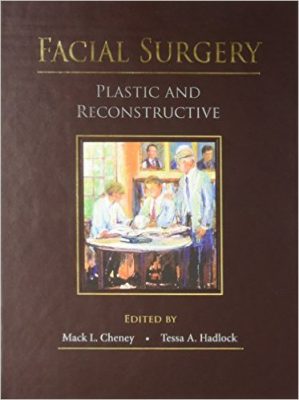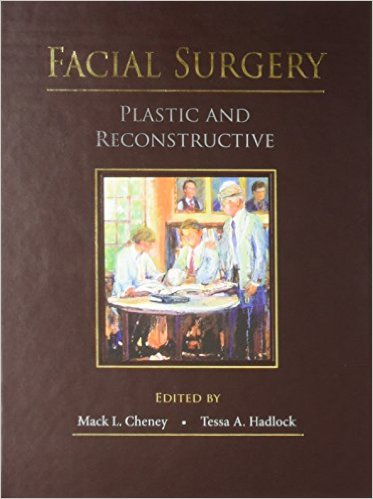 Editors: Mack L. Cheney, MD and Tessa A. Hadlock, MD
Editors: Mack L. Cheney, MD and Tessa A. Hadlock, MD
Publisher: Thieme 1,147 pages, plus Index
Book Review by: Nano Khilnani
Facial plastic and reconstructive surgery emerged as a subspecialty within otolaryngology (head and neck surgery) sometime around 1975 when surgeons decided to focus their work on aesthetic procedures on the face and develop their skills further in this area. We must also admit that the desire of some people to change their looks drove the growth of this subspecialty.
This book is the product of the work of 88 physicians and surgeons from all over the United States and five other countries – Canada, France, Germany, the Netherlands, and the United Kingdom – who authored the 51 chapters.
Most of them are specialists in facial plastic and reconstructive surgery, while some are in craniofacial surgery, dermatology, emergency medicine, oculoplastics, ophthalmology, oral and maxillofacial surgery, otology, otolaryngology, and rhinology.
The 51 chapters in this wide-ranging, two-volume book of numerous topics, are organized within facial zones and into four Parts named below to provide you an overview of its contents:
- Volume I
- Part I – General Principles
- Part II – Facial Surgery by Anatomic Site
- Section 1. Scalp and Forehead
- Section 2. Eyelids and Forehead
- Section 3. The Nose
- Section 4. The Ear
- Volume II
- Section 5. Bony Facial Skeleton
- Section 6. Facial Skin and Soft Tissue
- Part III – Conditions Affecting Multiple Facial Zones or Tissues
- Part IV – Emerging Trends and New Directions in Facial Plastic Surgery
- Volume I
- Part I has chapters 1 to 6: surgical anatomy of the face; attractiveness, proportions, and ethnic reflections of allure; imaging for facial surgery; wound healing and optimization, including skin grafting, tissue expansion, and soft tissue techniques; flap reconstruction: local, regional, and free tissue design principles; and principles of facial aging.
- Part II has chapters 7 to 42 within six sections:
- Section 1 – scalp reconstruction; hair restoration and scalp surgery; and brow lift.
- Section 2 – eyelid mal-positions; eyelid reconstruction; ptosis repair; orbital fractures; and blepharoplasty.
- Section 3 – acute nasal injuries; surgery of the nasal septum; closed rhinoplasty; open rhinoplasty; revision rhinoplasty; local flaps for nasal reconstruction; special problems in nasal reconstruction; and the total rhinectomy defect.
- Section 4 – acute auricular injuries; local flaps for auricular reconstruction; microtia reconstruction; otologic considerations in microtia and atresia; and otoplasty: surgical correction of the prominent ear.
- Volume II
- Section 5 – nasoethmoid complex; frontal sinus; and skull base fractures; midface fractures; mandibular fractures; implants and skeletal modifications; and free tissue for reconstruction of the bony facial skeleton.
- Section 6 – soft tissue injuries of the face; scar revision; local flaps for facial reconstruction, including cheek; pedicled flaps for facial reconstruction; free flaps for facial skin and soft tissue reconstruction; benign and malignant cutaneous neoplasms; melanoma of the head and neck; rhytidectomy; skin resurfacing: laser, chemical peels, and mechanical dermabrasion; and volume replacement and chemodenervation.
- Part III has chapters 43 to 47: impaired facial movement: paralysis, synkinesis, and spasm; craniofacial surgery; cleft lip and palate repair; secondary cleft palate and velopharyngeal function; and congenital vascular anomalies of the head
- Part IV has chapters 48 to 51: facial transplantation; evaluating patient outcomes in facial plastic surgery; tissue engineering for facial plastic surgery; and the role of facial plastic surgery in global health and education
As a purchaser of this print edition you can access the E-book version and other valuable resources available for you online. Go to https://online.vitalsource.com/user/new, then:
- Create your VitalSource Bookshelf account or log on to it if you already have an account.
- Redeem the code by scratching off the grey film on the inside front cover of this book
You can download the E-book version of this book on your PC or Mac, iPhone, iPad Touch, iPad, Android phone or other smart phone, tablet, or on your Kindle Fire. If you have any questions whatever on downloading, please visit: http://support.vitalsource.com/
A highly interesting chapter to take a close look at is chapter 48 entitled Facial Transplantation, authored by Daniel S. Alam and John J. Chi. They write that the world’s first partial face transplant was carried out in France in 2005 on a woman who was mauled by her dog “resulting in amputation of her distal nose, lips, chin, and portions of her midface.
(A Wikipedia article indicates that this revolutionary procedure was performed on Isabelle Dinkier whose face had been disfigured by her dog. The operation was done by a team of three surgeons: two French surgeons named Bernard Devauchelle and Jean-Michelle Dubernard, and a Belgian named Benoit Langele).
There have been other successful partial face transplantations in France, China, and Turkey. All of these cases, plus years of medical research that is helpful in carrying out such procedures, have raised hopes for now and into the future.
The first full face transplant was performed in Barcelona, Spain in March 2010 on a 30-year-old man with facial deformity as a result of ballistic trauma after a shooting accident. This was performed by a team of 30 Spanish doctors. Other full face transplants have been performed as well, particularly in France and in the United States.
In spite of these successes, partial and total face transplantations are highly complex in which optimal success is difficult to attain.
The authors write in this chapter: “the difficulty in subtotal facial reconstruction arises from the complexity of the face both in form and function. The face is composed of unique three-dimensional structures consisting of multiple tissue types. Because of its unique color, texture, and consistency, facial skin is often best reconstructed from adjacent areas within the face.”
There are other issues and matters to consider in face transplantation, not just such limitations of reconstructions, authors of this chapter point out. Among the topics they lay out and discuss are:
- Limitations of Conventional Reconstruction
- History of Allotransplantation
- The Importance of the Central Face
- The Rationale for Facial Transplantation
- Medical Risks
- Ethical Considerations
- Surgical Indications for Facial Transplantations
- Allograft Design and Classification Scheme
- Clinical Experience
In their Conclusion to this chapter Daniel S. Alam and John J. Chi state that while there has been early success in the first 25 or so partial and full face transplant operations, the long-term outlook for consistently satisfactory results remains an open question.
This book is great for several reasons: it provides an extensive array of different surgical procedures; it provides new and crucial knowledge in a relatively younger (less than 50 years) but rapidly-growing medical area; it is authoritative, written by 88 experienced specialist physicians and surgeons; it is broad in its coverage, with information on working on all parts and features of the face; and it is amply illustrated, a must for surgery books. In sum, this is an outstanding book on facial plastic and reconstructive surgery.
Editors:
Mack L. Cheney, MD is a Professor at Harvard Medical School, and Kletjian Chair and Director of Global Surgery in the Division of Plastic and Reconstructive Surgery at Massachusetts Eye and Ear Infirmary at Harvard Medical School in Boston, Massachusetts.
Tessa A. Hadlock, MD is Director of Facial Plastic and Reconstructive Surgery and Facial Nerve Center in the Department of Otolaryngology at Massachusetts Eye and Ear Infirmary in Boston, Massachusetts at Harvard Medical School in Boston, Massachusetts.
Illustrators:
Robert J. Galla, MSI
Tiffany Slaybaugh Davanzo, MA, CMI
Sarah J. Taylor, MSMI







